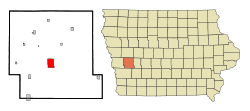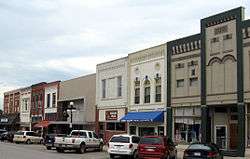Harlan, Iowa
| Harlan, Iowa | |
|---|---|
| City | |
|
Downtown Harlan | |
 Location of Harlan, Iowa | |
| Coordinates: 41°39′17″N 95°19′19″W / 41.65472°N 95.32194°WCoordinates: 41°39′17″N 95°19′19″W / 41.65472°N 95.32194°W | |
| Country |
|
| State |
|
| County | Shelby |
| Area[1] | |
| • Total | 4.39 sq mi (11.37 km2) |
| • Land | 4.39 sq mi (11.37 km2) |
| • Water | 0 sq mi (0 km2) |
| Elevation | 1,253 ft (382 m) |
| Population (2010)[2] | |
| • Total | 5,106 |
| • Estimate (2012[3]) | 5,085 |
| • Density | 1,163.1/sq mi (449.1/km2) |
| Time zone | Central (CST) (UTC-6) |
| • Summer (DST) | CDT (UTC-5) |
| ZIP codes | 51537, 51593 |
| Area code(s) | 712 |
| FIPS code | 19-34500 |
| GNIS feature ID | 0457259 |
| Website | City of Harlan |
Harlan is a city in Shelby County, Iowa, United States, along the West Nishnabotna River. The population was 5,106 at the 2010 census. It is the county seat of Shelby County.[4]
History
Harlan was platted in 1858.[5] It was named for one of Iowa's early U.S. Senators, James Harlan.[6] Harlan was designated county seat in 1859.[7] The town was incorporated on May 2, 1879.
Geography
Harlan's longitude and latitude coordinates
in decimal form are 41.654609, -95.322019.[8]
According to the United States Census Bureau, the city has a total area of 4.39 square miles (11.37 km2), all of it land.[1]
Demographics
| Historical populations | ||
|---|---|---|
| Year | Pop. | ±% |
| 1860 | 47 | — |
| 1870 | 128 | +172.3% |
| 1880 | 1,304 | +918.8% |
| 1890 | 1,765 | +35.4% |
| 1900 | 2,422 | +37.2% |
| 1910 | 2,570 | +6.1% |
| 1920 | 2,831 | +10.2% |
| 1930 | 3,145 | +11.1% |
| 1940 | 3,727 | +18.5% |
| 1950 | 3,915 | +5.0% |
| 1960 | 4,350 | +11.1% |
| 1970 | 5,049 | +16.1% |
| 1980 | 5,357 | +6.1% |
| 1990 | 5,148 | −3.9% |
| 2000 | 5,282 | +2.6% |
| 2010 | 5,106 | −3.3% |
| 2014 | 5,013 | −1.8% |
| 2015 | 5,002 | −0.2% |
| Source:"American FactFinder". United States Census Bureau. and Iowa Data Center Source: | ||
2010 census
As of the census[2] of 2010, there were 5,106 people, 2,222 households, and 1,341 families residing in the city. The population density was 1,163.1 inhabitants per square mile (449.1/km2). There were 2,410 housing units at an average density of 549.0 per square mile (212.0/km2). The racial makeup of the city was 97.0% White, 0.5% African American, 0.4% Native American, 0.6% Asian, 0.6% from other races, and 0.9% from two or more races. Hispanic or Latino of any race were 1.9% of the population.
There were 2,222 households of which 26.7% had children under the age of 18 living with them, 47.8% were married couples living together, 9.7% had a female householder with no husband present, 2.8% had a male householder with no wife present, and 39.6% were non-families. 34.2% of all households were made up of individuals and 17.7% had someone living alone who was 65 years of age or older. The average household size was 2.26 and the average family size was 2.88.
The median age in the city was 43.8 years. 23.8% of residents were under the age of 18; 6.1% were between the ages of 18 and 24; 21.4% were from 25 to 44; 27% were from 45 to 64; and 21.8% were 65 years of age or older. The gender makeup of the city was 46.4% male and 53.6% female.
2000 census
As of the census[10] of 2000, there were 5,282 people, 2,204 households, and 1,498 families residing in the city. The population density was 1,209.8 people per square mile (466.7/km²). There were 2,306 housing units at an average density of 528.2 per square mile (203.7/km²). The racial makeup of the city was 98.30% White, 0.08% African American, 0.30% Native American, 0.47% Asian, 0.17% from other races, and 0.68% from two or more races. Hispanic or Latino of any race were 0.62% of the population.
There were 2,204 households of which 31.1% included children under the age of 18; 56.6% were married couples living together, 8.9% consisted of a female householder with no husband present, and 32.0% were non-families. 28.9% of all households were made up of individuals and 16.3% had someone living alone who was 65 years of age or older. The average household size was 2.35, and the average family size was 2.88.
25.1% are under the age of 18, 6.1% from 18 to 24, 24.2% from 25 to 44, 22.4% from 45 to 64, and 22.3% who were 65 years of age or older. The median age was 41 years. For every 100 females there were 90.9 males. For every 100 females age 18 and over, there were 85.4 males.
The median income for a household in the city was $35,899, and the median income for a family was $45,888. Males had a median income of $31,365 versus $19,671 for females. The per capita income for the city was $17,514. About 5.3% of families and 7.0% of the population were below the poverty line, including 7.3% of those under age 18 and 9.4% of those age 65 or over.
Sports
Baseball: 2-time state champs, 1996 (3A), 2003 (3A) Boys' Basketball: 2-time state champs, 2004 (3A), 2006 (3A) Girls' Basketball: 1-time state champs, 2014 (4A) Girls' Cross Country: 1-time state champs, 2005 (3A); 1 Individual State Title Football: 12-time state champs, 1972 (3A), 1982 (3A), 1983 (3A), 1984 (3A), 1993 (3A), 1995 (3A), 1997 (3A), 1998 (3A), 2003 (3A), 2004 (3A), 2005 (3A), 2009 (3A) Boys' Golf: 2 Individual State Titles Girls' Golf: 2-time state champs, 1993 (2A), 1995 (2A); 1 Individual State Title Boys' Track-Indoor: 1-time state champs, 1948 (B) Boys' Track-Outdoor: 2-time state champs, 1954 (A), 2003 (3A); 14 Individual State Titles Girls' Track: 13 Individual State Titles Volleyball: 1-time state champs, 2013 (4A) Wrestling: 3-time state champs, 1967 (A); 4 Individual State Titles .[11] Harlan also is home to Shelby County Speedway which holds the Tiny Lund Memorial races held in September.
Education
The Harlan School District also serves residents of Jacksonville, Corley, Defiance, Panama, Portsmouth, Earling, and Westphalia.
Music
The Harlan Community School District excels in their musical abilities. The Harlan Community High School Jazz Band, nicknamed the Harlan Jazz Experience, has won the Iowa Jazz Championships in the class 3A in 2011, 2010, 2009, 2008.
Notable people
- Mary Lincoln Beckwith, great-grandchild of Abraham Lincoln
- Howard Webster Byers, Iowa Attorney General
- Billy Cundiff, NFL kicker, Washington Redskins
- Zach Daeges, baseball player
- George Sabin Gibbs, United States Army General
- Albert Hansen, college football coach
- Tiny Lund (1929–1975) NASCAR driver and 1963 winner of the Daytona 500[12]
- Raymond Eugene Plummer, lawyer and judge
- Lynn Reynolds, film director
See also
Building on the National Register of Historic Places
References
- 1 2 "US Gazetteer files 2010". United States Census Bureau. Retrieved 2012-05-11.
- 1 2 "American FactFinder". United States Census Bureau. Retrieved 2012-05-11.
- ↑ "Population Estimates". United States Census Bureau. Retrieved 2013-05-23.
- ↑ "Find a County". National Association of Counties. Retrieved 2011-06-07.
- ↑ White, Edward Speer (1915). Past and Present of Shelby County, Iowa, Volume 1. B.F. Bowen. p. 226.
- ↑ Gannett, Henry (1905). The Origin of Certain Place Names in the United States. Govt. Print. Off. p. 149.
- ↑ Chicago and North Western Railway Company (1908). A History of the Origin of the Place Names Connected with the Chicago & North Western and Chicago, St. Paul, Minneapolis & Omaha Railways. p. 81.
- ↑ "US Gazetteer files: 2010, 2000, and 1990". United States Census Bureau. 2011-02-12. Retrieved 2011-04-23.
- ↑ "Census of Population and Housing". Census.gov. Retrieved June 4, 2015.
- ↑ "American FactFinder". United States Census Bureau. Retrieved 2008-01-31.
- ↑ http://www.iahsaa.org/football/ARCHIVES/FB.4.CHAMPGAME.results.pdf 37
- ↑ "Tiny Lund". International Motorsports Hall of Fame. Retrieved 2011-01-15.
External links
| Wikimedia Commons has media related to Harlan, Iowa. |
- Harlan official website
- City-Data Comprehensive Statistical Data and more about Harlan
